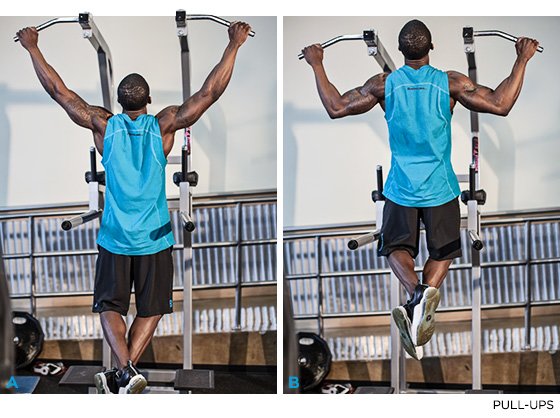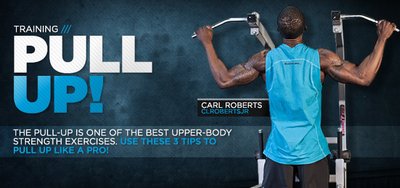Pull-ups with any grip variation are pivotal to improve strength, size, and remain injury-free. Legendary strength coach Charles Poliquin says pull-ups are the single most important exercise for upper body strength development. I agree. Plus, I think they're just plain badass.
I see many online articles devoted to building a bigger squat, deadlift, or bench press, but there's less content dedicated to programming the humble pull-up. Luckily, I'm here to save the day. Quite frankly, the simplest way to get better at pull-ups is to do pull-ups! Here are my simple tips and variations to help you perform powerful pull-ups quickly.

{{caption}}
1. Use Partials for Starting Strength
Partial reps don't only apply to the end of a working set when muscles are fatigued and can't go through the full range of motion. You can apply partial pull-ups with perfect form to fire up the back muscles.
Hang from a pull-up bar with a standard grip, avoid using momentum, and squeeze the chest upward to depress and retract the shoulder blades. Bend the elbows so the body moves up three inches, hold the contraction for one second, and relax. Perform sets of 6-10 reps depending on your strength.
Partials increase your initial strength from a dead hang. The lats and teres muscles must be especially strong from a fully-stretched position to drive the body upward at the start. This helps them fire up. It's a great exercise to begin a pulling workout and ensure the scapular muscles are engaged. Pull-up partials set the tone for the remainder of the workout by forcing blood into the muscles.
2. Focus on Negative Reps
Negative reps are great for people who can't do a single pull-up. They can also help you bust through a plateau because eccentric strength is greater than concentric strength. To clarify my point, there will come a time when you can't bench press the weight off your chest and you'll need a spotter to help the bar up. At the top position, you can lower the bar slowly because your stores of negative strength aren't terribly affected by the exercise. Hitting different fast-twitch muscle fibers with negatives is a vital resource to tap.
The best negative pull-ups, in my opinion, are those where you grab hold of a pull-up bar and assist yourself up to the top position. Jump up or use a box to bring your chin over the bar, avoid a freefall, attempt to maintain good form, and control your descent as much as possible. Start with 10-second negatives for 8 sets.
When you can extend one negative rep to 30 seconds, you should possess the strength to complete one full pull-up. Retest your longest possible negative pull-up weekly.
3. Use Ladders to Extend Sets
Ladder sets are a simple method to get more reps out of a sub-max effort. They're a perfect tool to employ if you're a lifter who can do a few pull-ups but hit a progression wall. Ladder sets tap into strength and muscular endurance and allow for repeated and prolonged lifting effort thanks to mini breaks.
Pull-Up Ladder Set Example:
- Perform 2 reps and rest for 15 seconds
- Perform 3 reps and rest for 15 seconds
- Perform 5 reps and rest for 15 seconds
- Perform 10 reps
For people who can't do more than 10-12 bodyweight pull-ups, ladder sets kick your rear into gear and break up a set of 20 reps. Use ladders before you perform weighted pull-ups. The back muscles are primarily composed of type 1 muscle fibers and are geared toward endurance. They keep your posture in check all day, after all. Training them for pure strength with low-rep, heavy loads isn't the best way to stimulate their growth. When you master ladders, add light weight to the belt, and do ladders again.
Honorable Mentions
1. Dead-Stop Pull-Ups
Dead-stop pull-ups require you to stop for two seconds and dead hang at the bottom of each rep, which eliminates the stretch reflex and keeps you from rebounding into the next rep. Ultimately it makes the set much harder.
2. Isometric Holds
Applying isometric holds during your negative reps are helpful to expose weak spots within your pull-ups. Perform negative pull-ups like above, but use a five-second isometric hold just shy of the top position (where the elbow is 90 degrees).
You're only as strong as what you can hold, so train your grip strength and forearms. Don't neglect deadlifts, loaded carries, and other pulling exercises that build grip strength. It creates a better force transfer through the upper body when your grip is invincible.

